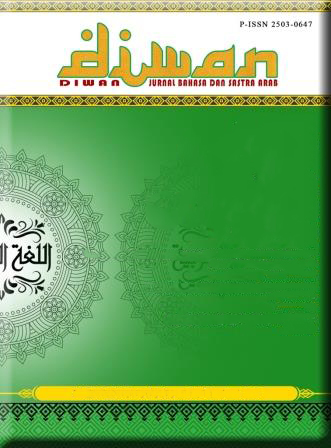Riffaterre's Semiotic Approach to Aḍḍamīru Al-’Arabī Song: Explores Lyrics as a Tool for Arab Integration
DOI:
https://doi.org/10.24252/diwan.v11i1.56446Keywords:
Song LyricAbstract
This study examines the meaning of Arab unity as reflected in the lyrics of the song “Aḍḍamīru al-’Arabī” through the lens of Riffaterre’s semiotic approach. The song was selected due to its powerful symbolism in advocating Arab solidarity. Employing a descriptive qualitative method, the research analyzes the text and context of the lyrics to reveal hidden meanings, ideologies, and symbolic messages. The analysis follows several stages: heuristic and hippogram identification, indirect expression analysis, and retrospective reading. The findings indicate that the song serves not only as a work of art but also as a political instrument in fostering solidarity amidst the Middle East conflict. This study contributes to the field of semiotic analysis and offers a new perspective on the intersection of music and politics within the scope of cultural diplomacy.
مستخلص
تبحث هذه الدراسة معنى الوحدة العربية كما تتجلى في كلمات أغنية "الضمير العربي" من خلال عدسة المنهج السيميائي لريفاتر. تم اختيار الأغنية بسبب رمزيتها القوية في الدعوة إلى التضامن العربي .باستخدام منهج وصفي نوعي، يحلل البحث نص كلمات الأغاني وسياقها للكشف عن المعاني الخفية والأيديولوجيات والرسائل الرمزية. يستغرق التحليل عدة مراحل: تحديد الاستدلال وتصوير فرس الأنساب، وتحليل التعبير غير المباشر، والقراءة بأثر رجعي. تشير النتائج إلى أن الأغنية لا تعمل كعمل فني فحسب، ولكن أيضا كإداة سياسية لتعزيز التضامن في خضم الصراع في الشرق الأوسط. تساهم هذه الدراسة في مجال التحليل السيميائي وتقدم منظورا جديدا حول تقاطع الموسيقى والسياسة في نطاق الدبلوماسية الثقافية.
Downloads
References
Baban, Feyzi, ‘Nationalism and the Crisis of Community in the Middle East’, Dialectical Anthropology, 42.4 (2018), 351–57 <https://doi.org/10.1007/s10624-018-9534-5>
Boms, Nir Tuvia, and Hussein Aboubakr, ‘Pan Arabism 2.0? The Struggle for a New Paradigm in the Middle East’, Religions, 13.1 (2021), 28 <https://doi.org/10.3390/rel13010028>
Choironi, Merry, Lalu Turjiman Ahmad, and Ahmad Autiyah Saber, ‘Semiotic Analysis of “Kun Fa Yakoon” Song Using Riffaterre’s Theory’, Jurnal Al Bayan: Jurnal Jurusan Pendidikan Bahasa Arab, 15.2 (2023), 339 <https://doi.org/10.24042/albayan.v15i2.16372>
Darwish, Housamedden, ‘From Peaceful Civil Movement to Civil War and Sectarian Polarization: A Critical Review of Kevin Mazur’s Revolution in Syria: Identity, Networks, and Repression’, International Sociology, 38.5 (2023), 552–61 <https://doi.org/10.1177/02685809231194134>
Dave, N., ‘Music and the Myth of Universality: Sounding Human Rights and Capabilities’, Journal of Human Rights Practice, 7.1 (2015), 1–17 <https://doi.org/10.1093/jhuman/huu025>
Hafez, Mohamad Hosam, ‘The Arab League : Its Foundation and Role in Arab Regional Security’, January, 2019
Hashemi, Nader, and Danny Postel, Sectarianization Mapping the New Politics of The Middle East (New York: Oxford University Press, 2017)
‘Israel-Hezbollah Escalation’ <https://www.csis.org/analysis/israel-hezbollah-escalation> [accessed 9 October 2024]
John W. Creswell, , Research Design Pendekatan Metode Kualitatif, Kuantitatif, Dan Campuran, cet-3 (Yogyakara: Pustaka Pelajar, 2018)
Kislenko, Ivan, ‘Debates on Global Sociology: “Unity and Diversity” of Interpretations’, The American Sociologist, 52.3 (2021), 579–90 <https://doi.org/10.1007/s12108-021-09478-0>
Kostenko, Yuri, ‘“Failed” Arab States–A Threat to Regional and International Stability’, in Turning Points of World Transformation (Singapore: Springer Nature Singapore, 2022), pp. 47–61 <https://doi.org/10.1007/978-981-19-1758-5_4>
Kraidy, Marwan M., Reality Television and Arab Politics (Cambridge: Cambridge University Press., 2009)
Man, Paul De, and Michael Riffaterre, ‘Hypogram and Inscription: Michael Riffaterre’s Poetics of Reading’, Diacritics, 11.4 (1981), 17 <https://doi.org/10.2307/464972>
Marina, and David Ottaway, ‘The Changing Geopolitics of the Middle East’, in A Tale of Four Worlds (Oxford University Press, 2019), pp. 51–74 <https://doi.org/10.1093/oso/9780190061715.003.0004>
Matthew B. Miles, and A. Michael Huberman, Qualitative Data Analysis, 2nd edn (California: SAGE Publications, 1994)
Meleong, Lexy J, Metode Penelitian Kualitatif, Revisi (Bandung: Remaja Rosdakarya, 2006)
Mitchell, Jocelyn Sage, ‘Transnational Identity and the Gulf Crisis: Changing Narratives of Belonging in Qatar’, International Affairs, 97.4 (2021), 929–44 <https://doi.org/10.1093/ia/iiab013>
Riffaterre, Michael, Semiotics of Poetry (Bloomington: Indiana University Press, 1978)
Rijo Lopes da Cunha, Maria M., ‘Music as Cultural Diplomacy: Analyzing the Role of Musical Flows from the Arab Levant to New Cultural Poles in the Arab Gulf in the Twenty-First Century’, in Music and Cultural Diplomacy in the Middle East (Cham: Springer International Publishing, 2024), pp. 221–40 <https://doi.org/10.1007/978-3-031-36279-8_10>
Del Sarto, Raffaella A., ‘Contentious Borders in the Middle East and North Africa: Context and Concepts’, International Affairs, 93.4 (2017), 767–87 <https://doi.org/10.1093/ia/iix070>
Shadab, Saima, ‘The New Arab Gulf: Evaluating the Success of Economic Diversification in the UAE’, in Social Change in the Gulf Region, 2023, pp. 415–30 <https://doi.org/10.1007/978-981-19-7796-1_25>
Taher, Shamal, and Huda Halawachy, ‘With Spray, Paint “The She!”: A Semiotic Panel to Graffiti on Iraqi Women in Tahrir Square, Baghdad (October 25th, 2019)’, Journal of Ecohumanism, 3.8 (2024) <https://doi.org/10.62754/joe.v3i8.5278>






